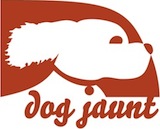Eating in a restaurant with a dog
This used to be part of Dog Jaunt’s “About” page, when I planned to provide you with a list of restaurants where we have eaten with Chloe concealed in her messenger bag (or out of her bag, with a wink from the management). It wasn’t bravado or counting coup — I just think that the nearly-universal ban on dogs in U.S. restaurants is lame, and I wanted to demonstrate that a quiet, clean, contained dog can accompany her owners to restaurants and be unobtrusive.
On second thought, I’ve decided to post only about restaurants that are comfortable with being described as dog-friendly. Why ruin a good thing for other dog owners by drawing a health inspector’s attention to restaurants that turn a blind eye to a well-behaved dog? And why get a restaurant in trouble that had no idea Chloe was with us?
The U.S. Food and Drug Administration recommends that dogs be prohibited from retail establishments where food is served (the code refers to other animals as well, but I’m focusing on dogs). It is up to the states to implement laws regarding dogs in restaurants, and the states have followed the FDA’s recommendation, with some variations (e.g., some states are open to variances or local ordinances that permit dogs in outdoor eating areas). Under the federal Americans with Disabilities Act, service dogs are permitted both indoors and in outdoor eating areas, and since there is currently no ID required to prove that your dog is a service dog, some people take inappropriate advantage of that exception. Here is an in-depth article about how the federal code, state laws and federal law interact.
The concerns underlying FDA code provision 6-501.115, and informing the comments that people post in places where the topic is discussed, include health hazards (restaurant staff patting the dogs and neglecting to wash their hands afterwards, and people allergic to dogs being exposed to dander), safety hazards (dogs tripping patrons or impeding progress through the restaurant), and annoyances (dogs urinating or defecating on the floor, or annoying other patrons by begging or otherwise seeking attention).
Here’s what I think. I think dogs should be allowed indoors in U.S. restaurants as long as they cannot be seen or heard or smelled, if there is no opportunity for them to pee or poop, and if they cannot shed on or lick another patron. Outdoors, on a patio or a sidewalk, I believe they should sit or lie quietly next to their owner, completely out of the path of the wait staff and patrons.
I cannot recall having ever been annoyed by a fellow patron’s dog in Europe, where well-behaved dogs often accompany their owners to restaurants. They have met all of my requirements for dogs in U.S. restaurants, except that they are visible.
By contrast, I have been repeatedly annoyed by the behavior and sound of babies and toddlers, who are welcomed in U.S. restaurants. Does anyone believe that a table that’s been drooled on by a baby is clean once a busboy swipes a quick towel over it? Haven’t we all been approached by a sticky toddler demanding conversation and amusement? Or heard a child in the midst of a meltdown? Why have babies and toddlers not been banned from U.S. retail establishments where food is served? [7/1/09: I’ve just been criticized as a kid-hater for this paragraph. I’ve deliberately described the worst of children in restaurants, because opponents of dogs in restaurants describe the worst imaginable canine behavior to make their point. I believe that clean and well-behaved children are a perfect delight in a restaurant, and I would love to see them joined by clean and well-behaved dogs.]
So here’s what I do. I will bring Chloe into a restaurant but only in her messenger bag. In it, she is silent, and generally falls asleep. I put her, in her bag, on the ground under my feet, not on a chair or bench. I do not pat her or otherwise interact with her, except that, from time to time, I may drop one of her usual treats in through the top hatch. (I do not give her food from my plate; I drop the treats in to amuse her and remind her of why she loves her messenger bag.) She has only been noticed twice: the first restaurant invited her out of her bag to enjoy the outdoor patio, and the second restaurant asked us to leave.
If you are asked to leave, go and with good grace. If you are asked whether there is an animal in your bag, tell the truth. Sometimes the person asking is a dog lover and is willing to bend the rules; sometimes you’ll be shown the door. Resisting or arguing would be inappropriate — you are, after all, breaking the law. It would also be inappropriate to fib about your dog being a service dog. Apologize for the mistake you made (my approach is big-eyed wonder that a dog in a bag isn’t okay), pay for what you have ordered, and depart gracefully.
Why bring Chloe to a restaurant at all, given that I’ve ensured that I can’t see, hear or smell her? For convenience. If I am out of the house all day, or on the road, it is convenient for me to eat at a restaurant. I will not leave my dog in the car, for health reasons (even in Seattle, cold or hot weather can threaten a dog’s life) and for security reasons (purebred dogs are a crime target, and the slightly-open window that provides her with ventilation also invites car theft).
I would not bring Chloe to a fancy restaurant because it’s unnecessary. A serious dinner is a special event, like going to the theater — it deserves a nice outfit, so I’ll need to return home anyway.





